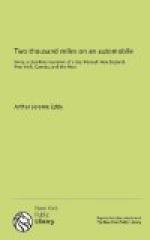The best plan, however, is to have a carburetor and motor that will use the ordinary “stove-grade;” as a matter of fact, it contains more carbon and more explosive energy if thoroughly ignited, but it does not make gas so readily in cold weather and requires a good hot spark.
All day we rode on through the valley, now far up on the hill-sides, now down by the meadows; past Palatine Church, Palatine Bridge; through Fonda and Amsterdam to Schenectady.
It was a glorious ride. The road winds along the side of the valley, following the graceful curves and swellings of the hills. The little towns are so lost in the recesses that one comes upon them quite unexpectedly, and, whirling through their one long main street, catches glimpses of quaint churches and buildings which fairly overhang the highway, and narrow vistas of lawns, trees, shrubbery, and flowers; then all is hidden by the next bend in the road.
During the long summer afternoon we sped onward through this beautiful valley. Far down on the tracks below trains would go scurrying by; now and then a slow freight would challenge our competition; trainmen would look up curiously; occasionally an engineer would sound a note of defiance or a blast of victory with his whistle.
The distant river followed lazily along, winding hither and thither through the lowland, now skirting the base of the hills, now bending far to the other side as if resentful of such rude obstructions to its once impetuous will.
Far across on the distant slopes we could see the cattle grazing, and farther still tiny specks that were human beings like ourselves moving upon the landscape. Nature’s slightest effort dwarfs man’s mightiest achievements. That great railroad with its many tracks and rushing trains seemed a child’s plaything,—a noisy, whirring, mechanical toy beside the lazy river; for did not that placid, murmuring, meandering stream in days gone by hollow out this valley? did not nature in moments of play rear those hills and carve out those distant mountains? Compared with these traces of giant handiwork, what are the works of man? just little putterings for our own convenience, just little utilizations of waste energies for our own purposes.
One should view nature with the setting sun. It may gratify a bustling curiosity to see nature at her toilet, but that is the part of a “Peeping Tom.”
The hour of sunrise is the hour for work, it is the hour when every living thing feels the impulse to do something. The birds do not fly to the tree-tops to view the morning sun, the animals do not rush forth from their lairs to watch the landscape lighten with the morning’s glow; no, all nature is refreshed and eager to be doing, not seeing; acting, not thinking. Man is no exception to this all-embracing rule; his innate being protests against idleness; the most secret cells of his organization are charged to overflowing with energy and demand relief in work.




